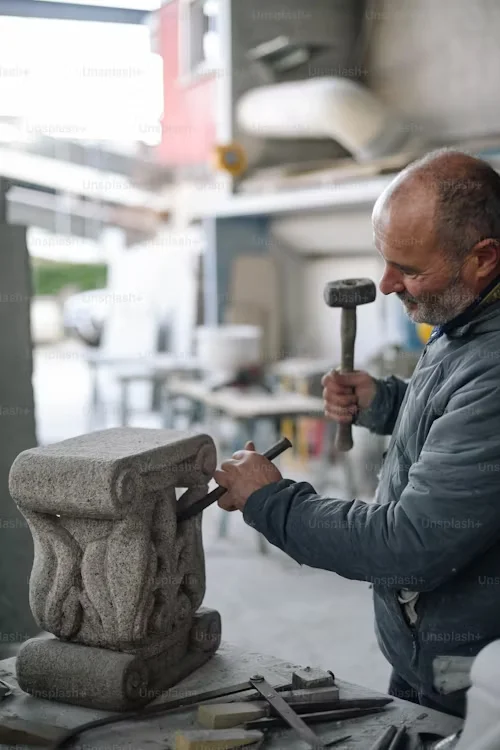London, a city rich in history and architecture, is home to skilled artisans whose work has shaped its iconic skyline and historical landmarks. Among these artisans, stonemasons stand out for their traditional craftsmanship, which has been passed down through generations. This blog delves into the world of stone masonry in London, exploring the timeless techniques and artistry behind this revered craft. Stonework services in London are renowned for preserving the city’s architectural heritage and providing expertise in restoration and new construction alike. Whether it’s restoring a historic facade or creating a bespoke stone feature, London-based stonework services bring a level of skill and dedication that ensures the longevity and beauty of each project.

London’s Historic Landmarks Built with Stonemasonry
Stonemasonry in London dates back to Roman times, with ancient structures like the London Wall showcasing the early use of stone in construction. Over the centuries, stonemasons have played a pivotal role in building some of the city’s most famous landmarks, including Westminster Abbey, the Tower of London, and St. Paul’s Cathedral. Their work is not just about construction but about creating enduring symbols of architectural beauty and cultural significance.
The Craftsmanship of Stonemasonry
Traditional stone masonry is both an art and a science. The craft involves working with natural stone, including limestone, sandstone, and marble, to create structures, sculptures, and intricate details. Here’s a glimpse into the traditional techniques employed by London’s stonemasons:

Quarrying and Selection
The process begins with selecting the right type of stone for a project. Stonemasons in London often source their materials from local quarries, ensuring that the stone complements the architectural style and historical context of the building. Each type of stone has unique characteristics, including colour, texture, and durability, which influence its suitability for various applications.
Carving and Shaping
Once the stone is quarried, it’s shaped and carved using traditional tools such as chisels, hammers, and mallets. This stage requires a high level of skill and precision, as stonemasons must follow detailed designs and plans. The techniques used have remained largely unchanged for centuries, relying on the craftsman’s ability to transform a rough block of stone into a finely detailed architectural element or sculpture.

Masonry Techniques
Traditional masonry techniques include ashlar and rubble construction. Ashlar masonry involves cutting stones into rectangular blocks with precise edges, allowing them to fit together perfectly. This method is often used in prestigious buildings for its clean, uniform appearance. Rubble masonry, on the other hand, involves using irregularly shaped stones, which are carefully arranged to create a more rustic and textured finish.
Modern Applications and Preservation
While traditional techniques remain at the heart of stone masonry, modern stonemasons in London also adapt their skills to contemporary needs. This includes restoring historical buildings, creating bespoke stonework for new constructions, and even incorporating innovative design elements into their projects.
Preservation work is particularly crucial in London, where many historic buildings require ongoing maintenance to protect their heritage. Stonemasons play a vital role in this area, meticulously repairing and restoring stonework to ensure that the city’s architectural legacy is preserved for future generations.
The Future of Stonemasonry
As with many traditional crafts, the future of stonemasonry faces both challenges and opportunities. While the demand for skilled stonemasons continues, there is a growing need to balance traditional techniques with modern advancements. Training and apprenticeships are essential to keeping the craft alive, ensuring that new generations of stonemasons can carry on the rich legacy of their predecessors.
In London, the dedication of stonemasons to preserving and advancing their craft is a testament to the enduring appeal of traditional craftsmanship. Their work not only contributes to the city’s architectural beauty but also preserves the historical and cultural identity of London.
Read More – Home Extension with Brickwork, Blockwork, and Stonemasonry: A Comprehensive Guide
Conclusion
Stonemasons in London embody the spirit of traditional craftsmanship, blending age-old techniques with a deep respect for history and artistry. Their skillful work has shaped some of the city’s most iconic structures, leaving a lasting impact on its architectural landscape. As we admire the stonework that defines London’s skyline, we also honor the timeless craft of the stonemasons who have brought these structures to life.
For those interested in exploring this fascinating craft, London offers a range of opportunities, from visiting historic sites to engaging with contemporary stone masonry projects. The legacy of stone masonry is a vibrant part of the city’s heritage, continuing to inspire and captivate those who appreciate the art of working with stone.
Website: JS Shoker Brickwork
Phone: +44-7403201624
Email: info@jsshokerbrickwork.co.uk



